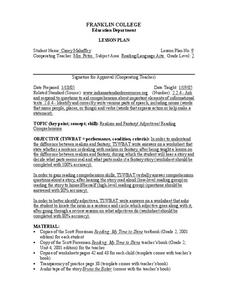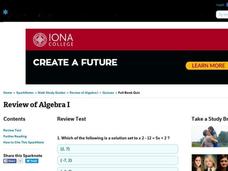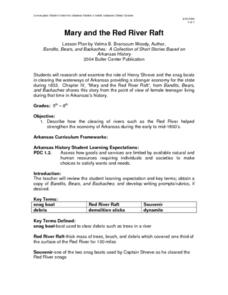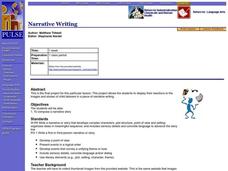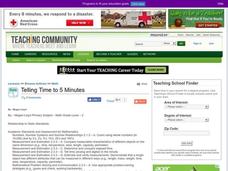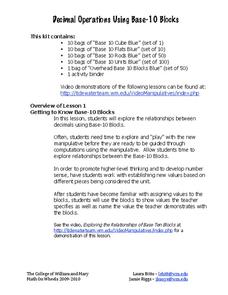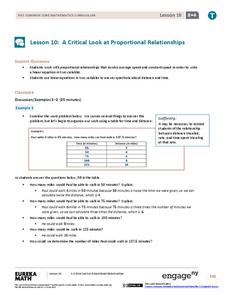Curated OER
Realism and Fantasy
Second graders listen to the story, Bruno the Baker, where some parts seem real and some seem fake. They must identify the parts of the story as realism or fantasy. An interesting way to teach young readers these two concepts.
Carnegie Mellon University
Lab Report
A set of instructions and a 100-point grading rubric have been designed for writing lab reports. Appropriate for middle schoolers, this lays out what to include for each of the six steps in the scientific method: title, hypothesis,...
Curated OER
Worksheet 27 - Functions
In this function worksheet, students sketch the graph of a nonzero function, estimate the value of an infinite sum, and determine the derivative and slope of functions. This one-page worksheet contains approximately 6 multi-step problems.
Curated OER
Review of Algebra I
Test your class with this online review. They determine the probability of a given situation, solve inequalities, systems of equations, and write numbers in scientific notation. This two-page worksheet contains approximately 60...
Curated OER
Oceans: Reading Comprehension
Practice reading comprehension by approaching oceanography through 2 pages of informational text. The text give introductory coverage of oceanography in practice, ocean zones, names of the 5 oceans, ocean features, and marine life. Three...
Curated OER
My Summer Vacation: Traveling
A classic instructional activity idea, kindergarteners share stories about their summer vacations on their first day of school! First, your young learners will listen to you talk about your summer vacation, making sure to use plenty of...
Curated OER
Mary and the Red River Raft
Upper elementary and middle schoolers examine how the clearing of rivers such as the Red River helped to boost the Arkansas economy of the mid-1800's. They listen to a story called, "Mary and the Red River Raft," then conduct research on...
Curated OER
Narrative Writing
Imagine a day in the life of a child who has to work 12-14 hours a day, seven days a week. After viewing images and reading stories of child laborers, class members select an image and write a richly detailed narrative about a typical...
Curated OER
Soil Porosity, Moisture Content, pH, and Density
This lab activity does not have to be done with AP environmental scientists. It can also be done with middle to high school earth scientists. The procedures aren't complex. Learners determine the density of dry and wet sand in order to...
Curated OER
Telling Time to 5 Minutes
In this second grade lesson your class will practice telling time. The goal is to tell time to five minutes using an analog clock. Your young students count by 5 minute intervals and discuss elapsed time.
Curated OER
The Art of Persuasion-Analysis of Argument
Analyze advertising techniques in order to pinpoint persuasive strategies that writers use. These same techniques are then examined in persuasive speeches. You will have to find your own advertisements, but speeches are included. Finish...
Curated OER
Vapor Pressure and Boiling
In this vapor pressure worksheet, students use a graph showing vapor pressure curves for two substances to complete 10 problems.
National Security Agency
Sampling for a Rock Concert
Over the course of three class periods, middle schoolers design an experiment to provide learner input to administration about which rock band to invite to play at school. They practice several random sampling exercises, all well...
Curated OER
Place Value Charts to the Millions Place
In this math worksheet, students learn to read, write, order and compare numbers and place them on a place value chart. Students begin the 4 pages of exercises by studying a sample place value chart. Students then fill out 3 other charts...
Curated OER
Constructing a Phylogenetic Tree Using DNA Sequence Data
Students analyze DNA sequence differences between organisms in order to establish a reasonable picture of the evolutionary relationships between them. They take the role of molecular biologists and make genetic changes and constructing...
Curated OER
Problem Solving Strategies
In this problem solving strategies learning exercise, students solve and complete 5 different word problems that include logic and the process of elimination. First, they determine the number of questions asked to determine a selected...
Curated OER
Finding the next Numbers in a Sequence
In this sequence activity, students identify the next three numbers in a given sequence. The solution to the problem is provided.
Curated OER
Whole Numbers: Worksheet 2
In this whole number activity, students write numbers in words, write word phrases in numbers, determine place value, fill in missing numbers, round, estimate, and place numbers in ascending order.
Curated OER
100 Years of Flight
Students investigate Bernoulli's principle of air pressure and how it
relates to the lift of an airplane. Students identify various Aeronautical vocabulary terms. Students construct a paper glider and experiment with the control surfaces...
Curated OER
Addition: Number Bonds to 40
In this addition and subtraction activity, students use their problem solving skills to solve 41 problems as they fill in the missing numbers in each of the problems.
Curated OER
Informal Writing 1
Students examine characteristics of informal writing. Students read through a class story. They rewrite the story so that it sounds if they were explaining the story to a friend. Students discover the use of apostrophes and...
Willow Tree
Bar Graphs
Circles, lines, dots, boxes: graphs come in all shapes in sizes. Scholars learn how to make a bar graph using univariate data. They also analyze data using those bar graphs.
College of William and Mary
Decimal Operations Using Base 10 Blocks
Let's get this block party started and learn about decimals! Here are four main lessons that teach the operations with decimals while using base 10 blocks to provide a hands-on learning approach. Supplemental worksheets and other...
EngageNY
A Critical Look at Proportional Relationships
Use proportions to determine the travel distance in a given amount of time. The 10th installment in a series of 33 uses tables and descriptions to determine a person's constant speed. Using the constant speed, pupils write a linear...
